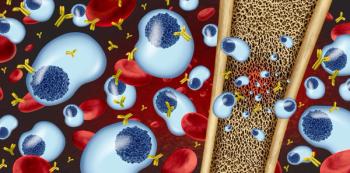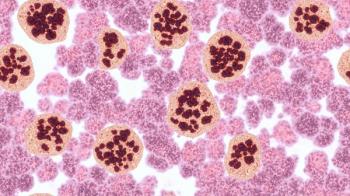
Local Therapy Plus Standard Chemotherapy May Improve Survival in Advanced Lung Cancer
Consolidative radiation followed by chemotherapy could play a key role in future survival outcomes among patients with non-small cell lung cancer.
Radiation therapy in conjunction with standard chemotherapy was found to improve treatment response and survival in patients with advanced non-small cell lung cancer (NSCLC).
NSCLC is the most common type of lung cancer, accounting for 80% to 85% of all lung cancer diagnoses, according to the American Society of Clinical Oncology. Although treatable when caught in its early stages, prognosis is poor once the disease metastasizes.
In a randomized phase 2 clinical trial, investigators sought to determine whether the addition of localized consolidative radiation therapy to systemic therapy improved progression-free survival (PFS) in patients with limited metastatic
The findings were presented at the 59th Annual Meeting of the American Society for Radiation Oncology (ASTRO).
“Even in the era of immunotherapy, there are not large numbers of metastatic NSCLC patients with durable response to systemic therapy,” said lead author Puneeth Iyengar, MD, PhD. “In our trial, however, the addition of radiation therapy directed at each of the cancerous areas greatly improved how patients respond to subsequent rounds of chemotherapy.”
Eligibility included patients with stage IV disease, spread to 6 or fewer sites including the primary tumor site, and at least partial response to first-line chemotherapy. A total of 29 patients were enrolled in the study, 86% of whom had tumors with non-squamous histologies.
The participants were randomized to receive either maintenance chemotherapy alone or stereotactic body radiation therapy (SBRT) to all disease sites followed by maintenance chemotherapy.
Radiation to metastases was offered as a single fraction, 3 fractions, or 5 fractions of SBRT. When possible, radiation to the primary disease site was delivered using SBRT, or via 15 fractions of hypofractionated radiation therapy if the tumor was too central or involved mediastinal nodes.
Thirty-one lesions were treated with radiation in 14 patients undergoing local therapy, according to the study. The median follow-up was 9.6 months.
Findings from an unplanned interim analysis showed substantial improvement in survival rates among patients receiving local therapy, which matched similar findings in a parallel trial.
The results of the interim analysis showed a median PFS rate of 9.7 months with consolidative radiation followed by chemotherapy, compared with 3.5 months for maintenance chemotherapy alone.
“This finding suggests that local treatments, including radiation, could work in concert with chemotherapy to prolong the amount of time before recurrence occurs in patients with limited sites of metastatic NSCLC,” Dr Iyengar said.
Additionally, findings showed patients in the consolidative local therapy arm experienced no recurrences in original sites of gross disease compared with 7 failures in original sites of gross disease in the maintenance therapy only arm.
Of the patients receiving maintenance chemotherapy-only, 10 of 15 progressed, compared with 4 of 14 patients who also received radiation. None of the recurrences in patients who also received radiation were in areas treated directly with radiation therapy.
The addition of local therapy was well-tolerated among the participants, with similar treatment-related adverse events found between the 2 treatment arms.
There were 2 grade 3 and 1 grade 4 toxicities reported in the maintenance chemotherapy-only arm, and 1 grade 4 toxicity in the SBRT plus maintenance chemotherapy arm.
“The findings verify that progression-free survival for limited metastatic disease really is no different than it is for widely metastatic disease, suggesting that local therapy could play an important future role in survival outcomes,” Dr Iyengar said. “Moreover, the addition of consolidative radiation did not increase toxicity, which allowed patients to continue on to additional systemic therapy that is important to controlling aggressive metastatic disease.”
According to the authors, next steps will include a larger, randomized phase 3 trial to test PFS and overall survival.
“There is a significant possibility that local therapy, such as consolidative radiation, may become an important part of the management of limited metastatic NSCLC patients, but this validation must take place in randomized phase 3 studies,” Dr Iyengar said. “Interested patients should seek more information about the ongoing NRG LU 002 and SARON trials.”
Newsletter
Stay informed on drug updates, treatment guidelines, and pharmacy practice trends—subscribe to Pharmacy Times for weekly clinical insights.




















































































































































































































